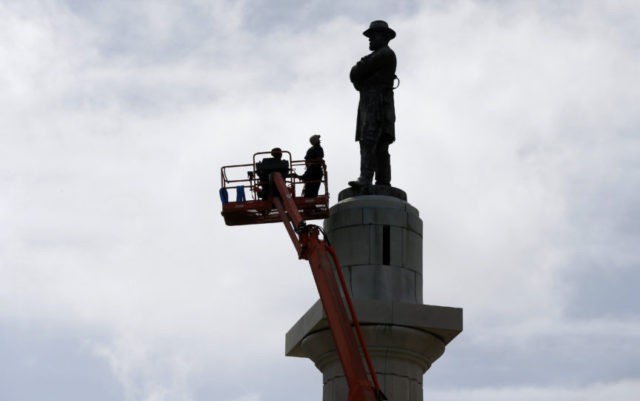NEW ORLEANS (AP) — They are among the city’s oldest landmarks, as cemented to the landscape of New Orleans as the Superdome and St. Louis Cathedral: a stone obelisk heralding white supremacy and three statues of Confederate stalwarts.
But after decades standing sentinel over this Southern city, the Confederate monuments are all but gone, amid a controversy that at times hearkened back to the divisiveness of the Civil War they commemorated.
The last of the monuments — a statue of Gen. Robert E. Lee facing defiantly north with his arms crossed — was expected to be lifted from its pedestal late Friday.
Lee’s will be the last of four monuments to Confederate-era figures to be removed under a 2015 City Council vote on a proposal by Mayor Mitch Landrieu. It caps a nearly two-year-long process that has been railed against by those who feel the monuments are a part of Southern heritage and honor the dead. But removal of the monuments has drawn praise from those who saw them as brutal reminders of slavery and symbols of the historic oppression of black people.
Landrieu called for the monuments’ removal in the lingering emotional aftermath of the 2015 massacre of nine black parishioners at a South Carolina church. The killer, Dylann Roof, was an avowed racist who brandished Confederate battle flags in photos, recharging the debate over whether Confederate emblems represent racism or an honorable heritage.
While Roof’s actions spurred a debate in many parts of the South about whether it was appropriate to fly the Confederate battle emblem — and many places have taken it down — the reaction in New Orleans seemed to go even further, knocking away at even weightier, heavier parts of history.
Landrieu drew blistering criticism from monument supporters and even some political allies. But in explaining his reasoning, the mayor has repeatedly said they do not represent the diversity and future of New Orleans.
“These statues are not just stone and metal. They are not just innocent remembrances of a benign history. These monuments celebrate a fictional, sanitized Confederacy; ignoring the death, ignoring the enslavement, ignoring the terror that it actually stood for,” he said Friday.
“After the Civil War, these statues were a part of that terrorism, as much as burning a cross on someone’s lawn. They were erected purposefully to send a strong message to all who walked in their shadows about who was still in charge in this city,” he added.
Of the four monuments, Lee’s was easily the most prominent: The bronze statue alone is close to 20 feet (6 meters) tall. It’s a bronze sculpture of Lee looking toward the northern horizon from atop a roughly 60-foot-tall column.
It’s not massive like the Superdome or alluring like Bourbon Street, but Lee in his uniform was a familiar landmark for tourists and commuters alike.
Lee’s removal was planned during the day, and announced in advance. Earlier removals happened after nightfall, a precautionary measure due to security concerns for contractors and workers involved in the effort. Landrieu said the change was out of safety concerns because the statue was close to electrical wires and New Orleans’ famous streetcar lines.
The atmosphere Friday was almost festive as dozens of people, some with lawn chairs, came out to see what many called history in the making.
“If you can see history as it happens, it’s more meaningful,” said Al Kennedy, who supported the removal. Speaking of the Confederate past, he said: “It’s my history, but it’s not my heritage.”
In 2015, the City Council voted 6-1 to remove the monuments after a succession of contentious public meetings. Contractors involved in the removal process have been threatened; statue supporters sued repeatedly to keep the statues up.
At last, a court decision cleared the way for the April removal of what is likely the most controversial of the monuments — seen as an overt tribute to white supremacy. Statues to the Confederacy’s only president Jefferson Davis and Gen. P.G.T. Beauregard followed in quick succession until only Lee was left.
Attention now shifts to where the monuments will go and what will take their place.
The city announced an outline of its plans late Thursday. It said it has received offers from public and private institutions to take individual monuments, so it will solicit proposals on where they will go through an “open and transparent selection.” Only nonprofits and government entities will be allowed to take part, and the city said the process will not include the Beauregard statue because of legal issues.
The city said those taking the statues cannot display them outdoors on public property in New Orleans.
The city plans to leave the column at Lee’s Circle intact and will mount public art in its place.
An American flag will stand where the Davis statue used to be, and the area where the Liberty Place monument used to stand “will remain as is.” The City Park Improvement Association, civic groups and the city will decide what will go where the Beauregard statue once stood.
The city wants to finish the work during its tricentennial year in 2018.
__
Associated Press writers Kevin McGill in New Orleans and Jesse J. Holland in Washington contributed to this report.

COMMENTS
Please let us know if you're having issues with commenting.